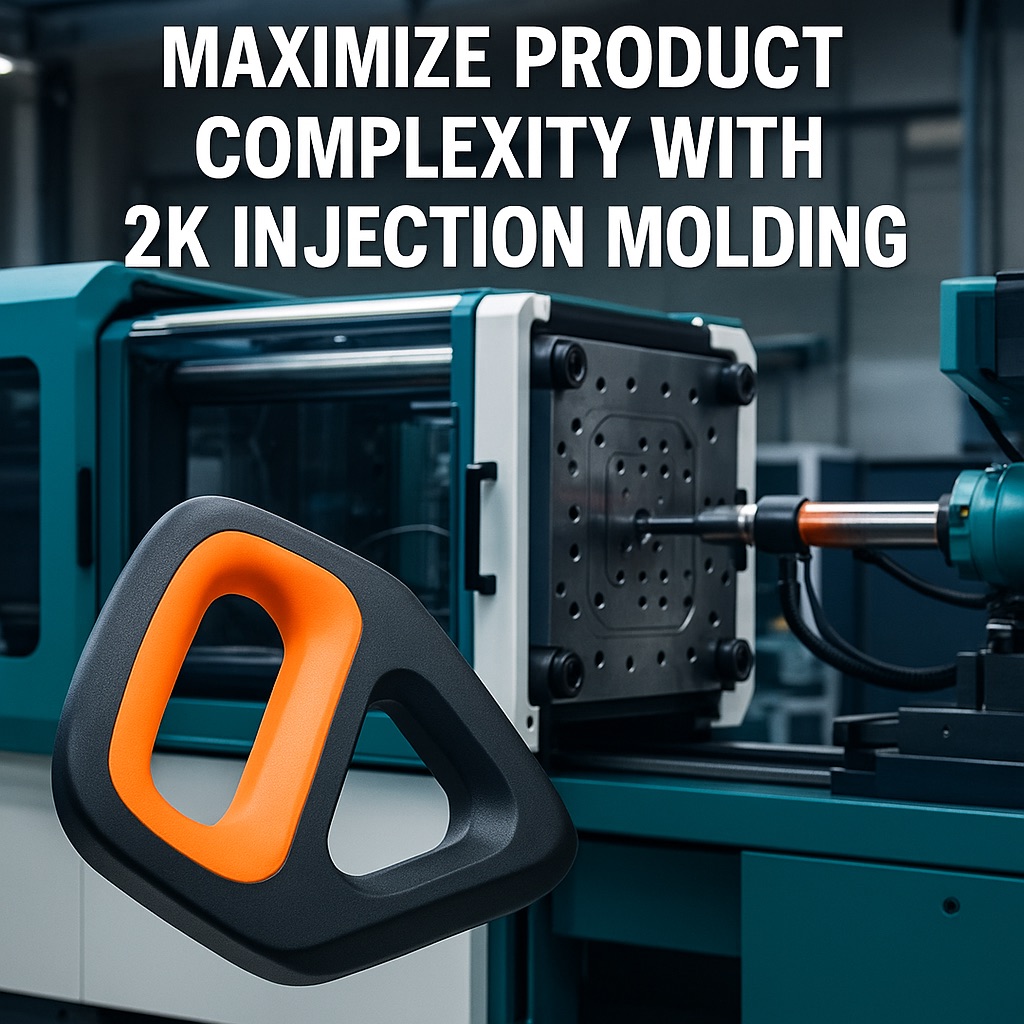Maximize Product Complexity With 2K Injection Molding for Multi-Component Parts
Maximize Product Complexity With 2K Injection Molding for Multi-Component Parts
Two-component (2K) injection molding—also called multi-material or bi-shot molding—combines two distinct polymers (or colors) in a single press cycle. That union unlocks design freedom impossible with traditional single-shot molding or post-mold assembly: tactile buttons fused to rigid housings, transparent windows inset into opaque frames, or soft gaskets chemically bonded to structural substrates. Follow the framework below to turn 2K technology into a competitive advantage for wearables, medical devices, automotive interiors, and premium appliances.
1 What Makes 2K Injection Molding a Complexity Game-Changer?
| Design Goal | Traditional Solution | 2K Injection-Molding Advantage |
|---|---|---|
| Multi-Material Fusion | Adhesive bonding or mechanical clips | Melt-state adhesion—no glue lines or loose parts |
| Multi-Color Aesthetics | Paint or pad-print | In-mold color transitions, zero overspray |
| Embedded Sealing | Post-mold gasket install | Integrated soft-touch TPE seals; IP-rated in one shot |
| Weight & Part Consolidation | Multiple assemblies | Mono-piece designs, lighter BOM, fewer fasteners |
| Precision Alignment | Manual sub-assembly variability | Single cavity; ±0.05 mm color-line registration |
2 Design Guildelines for 2K Success
| Aspect | Best Practice | Why It Matters |
|---|---|---|
| Substrate vs. Over-Mold Order | Mold rigid substrate first, soft or decorative layer second | Ensures chemical or mechanical locking |
| Overlap Geometry | ≥ 0.5 mm overlap or undercut tongue | Prevents delamination under torsion |
| Wall-Thickness Ratio | Second shot ≤ 70 % of first | Minimizes warpage and sink |
| Draft Angles | ≥ 1° on both shots (adjust for texture) | Clean ejection; avoids stress-whitening |
| Gate Placement | Hide knit-lines under ribs or logos; balanced valve-gate sequencing | Crisp color boundaries, no swirl |
3 Material Compatibility Matrix
| Substrate (1st Shot) | Over-Mold (2nd Shot) | Bond Strength | Typical Use |
|---|---|---|---|
| PC / PC-ABS | Medical-grade TPE | ★★★★ | Handheld electronics, smart watches |
| PP | SEBS-TPE | ★★★ | Appliance knobs, protective caps |
| PA66-GF | TPU 60 ShA | ★★★ | Automotive pedals & grips |
| Clear PC | Tinted PC | ★★★★ | Dual-color light pipes |
| PEEK | PEEK (pigmented) | ★★★★★* | Implantable components |
*Mono-material grades with different additives deliver perfect chemical fusion and simplify recycling.
4 Choosing the Right 2K Tooling & Press
| Decision Point | Rotary Platen | Shuttle / Transfer | Index Plate |
|---|---|---|---|
| Part Symmetry | Symmetrical parts, high volume | Asymmetrical, medium volume | Small, high-volume parts |
| Cycle Time | Fastest (simultaneous shot) | 10–15 % slower | Very fast for compact molds |
| Cost | Highest upfront | Moderate | Low-moderate |
| Footprint | Single press | Single press | Single press |
Hot-runner layout: Dual manifold, independent zone control—critical for color consistency and precise shut-off.
5 Process Window—Key Parameters
| Parameter | Target Range | Purpose |
|---|---|---|
| First-Shot Melt Temp | 220–280 °C (polymer specific) | Ensures substrate surface heat for bonding |
| Transfer Time (Index/Rotate) | ≤ 2 s | Retains interface temperature above Tg |
| Second-Shot Melt Temp | 10–20 °C above first | Promotes fusion, reduces surface stress |
| Mold Temp Control | Dual-zone ± 0.5 °C | Balances shrinkage; keeps color line tight |
| Pack/Hold Strategy | Sensor-based V/P switchover on both shots | Eliminates voids, maintains dimensional CpK ≥ 1.67 |
6 Validation & Quality Assurance
-
Peel / Lap-Shear Test—ASTM D 3167 or ISO 11339; aim for > 6 N/cm peel.
-
Cross-Section Microscopy—Verify overlap depth, void absence, and color alignment.
-
Laser-Vision Inspection—Real-time ΔX ≤ 0.05 mm between color edges.
-
Environmental Cycling—-30 °C → 80 °C, 500 cycles; no delamination or gloss loss.
7 Cost & Lead-Time Snapshot (2K vs. Over-Mold)
| Metric | Over-Mold (Two Tools) | 2K Single Tool |
|---|---|---|
| Upfront Tooling | US $42 k | US $55 k |
| Combined Cycle Time | 55 s + transfer | 38 s |
| Unit Cost @ 200 k pcs/yr | US $1.85 | US $1.52 |
| Alignment Rejects | 2.8 % | 0.4 % |
| Payback on Tool Premium | — | < 9 months |
8 Accelerate 2K Projects With TaiwanMoldMaker.com
-
48-hour DFM & Material Compatibility Report—gate, overlap, and valve-gate sequence recommendations.
-
In-House Dual-Shot Press Fleet—120 t – 450 t rotary and index machines with cavity-pressure sensors.
-
Integrated Secondary Processes—hard-coat, UV print, laser marking under one roof.
-
Prototype-to-Production Credits—aluminium pilot tools offset against H13 multi-cavity molds.
???? One-Stop Internal Links
(Bold anchor text boosts on-site SEO and click-through rates.)
Ready to Multiply Your Product’s Complexity—Without Multiplying Costs?
Upload your CAD files and performance targets to TaiwanMoldMaker.com. Within 48 hours, you’ll receive a no-obligation 2K DFM pack, material-pairing matrix, and costed timeline that turn ambitious multi-component designs into production-ready reality.









